Comprehensive Health Care Strategies for Aged Care in Australia
VerifiedAdded on 2023/06/15
|12
|3275
|490
Report
AI Summary
This report provides an overview of the Australian aged care industry, focusing on its growth, segmentation, and the strategies employed by companies like Bupa Aged Care. It examines the industry's landscape, including competition from new entrants, demographic changes, funding models, and ethical considerations. The report highlights the importance of aged care in Australia, both for the well-being of the elderly population and its contribution to the economy. It also touches upon the challenges and opportunities arising from an aging population and the shift towards a more market-driven, customer-focused approach to aged care funding and service delivery.
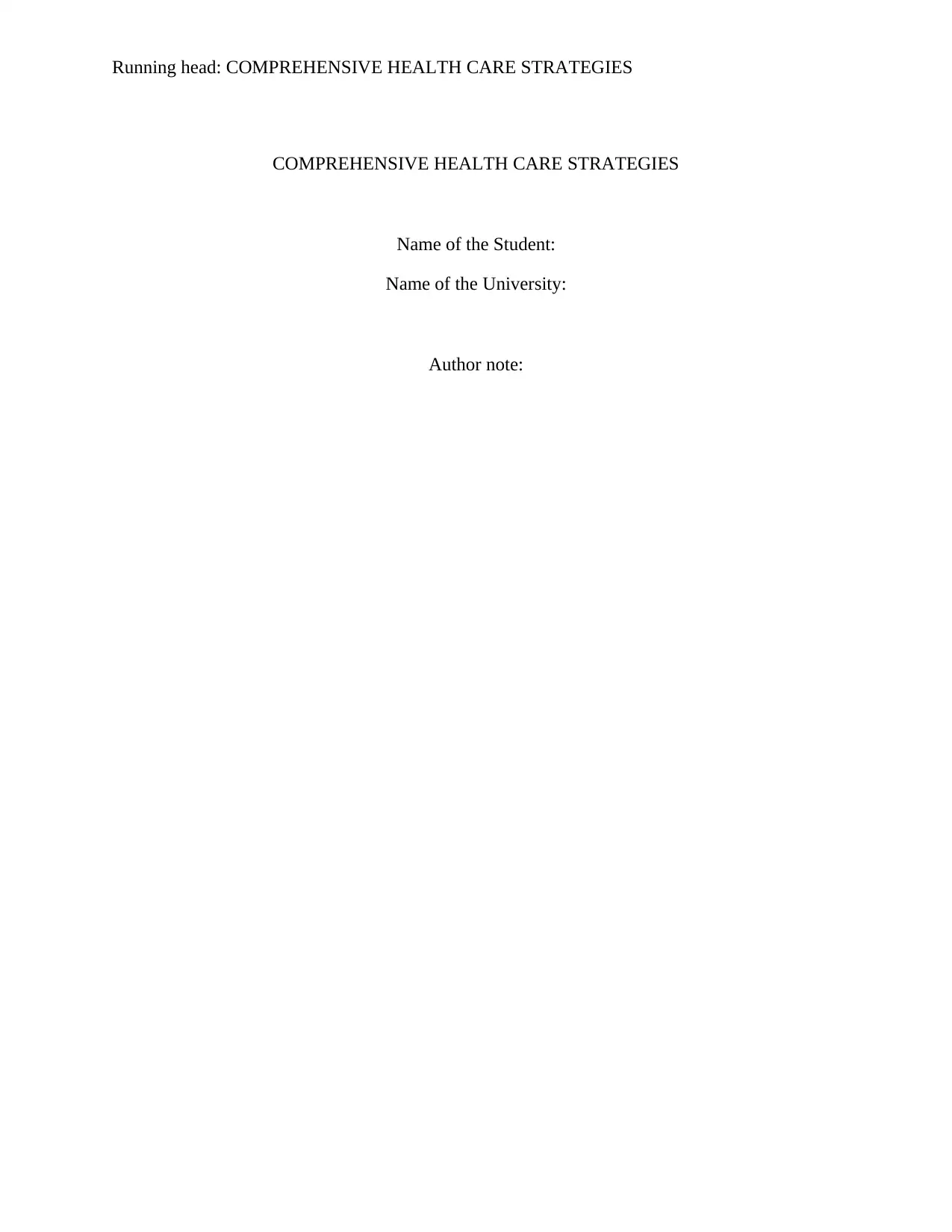
Running head: COMPREHENSIVE HEALTH CARE STRATEGIES
COMPREHENSIVE HEALTH CARE STRATEGIES
Name of the Student:
Name of the University:
Author note:
COMPREHENSIVE HEALTH CARE STRATEGIES
Name of the Student:
Name of the University:
Author note:
Paraphrase This Document
Need a fresh take? Get an instant paraphrase of this document with our AI Paraphraser
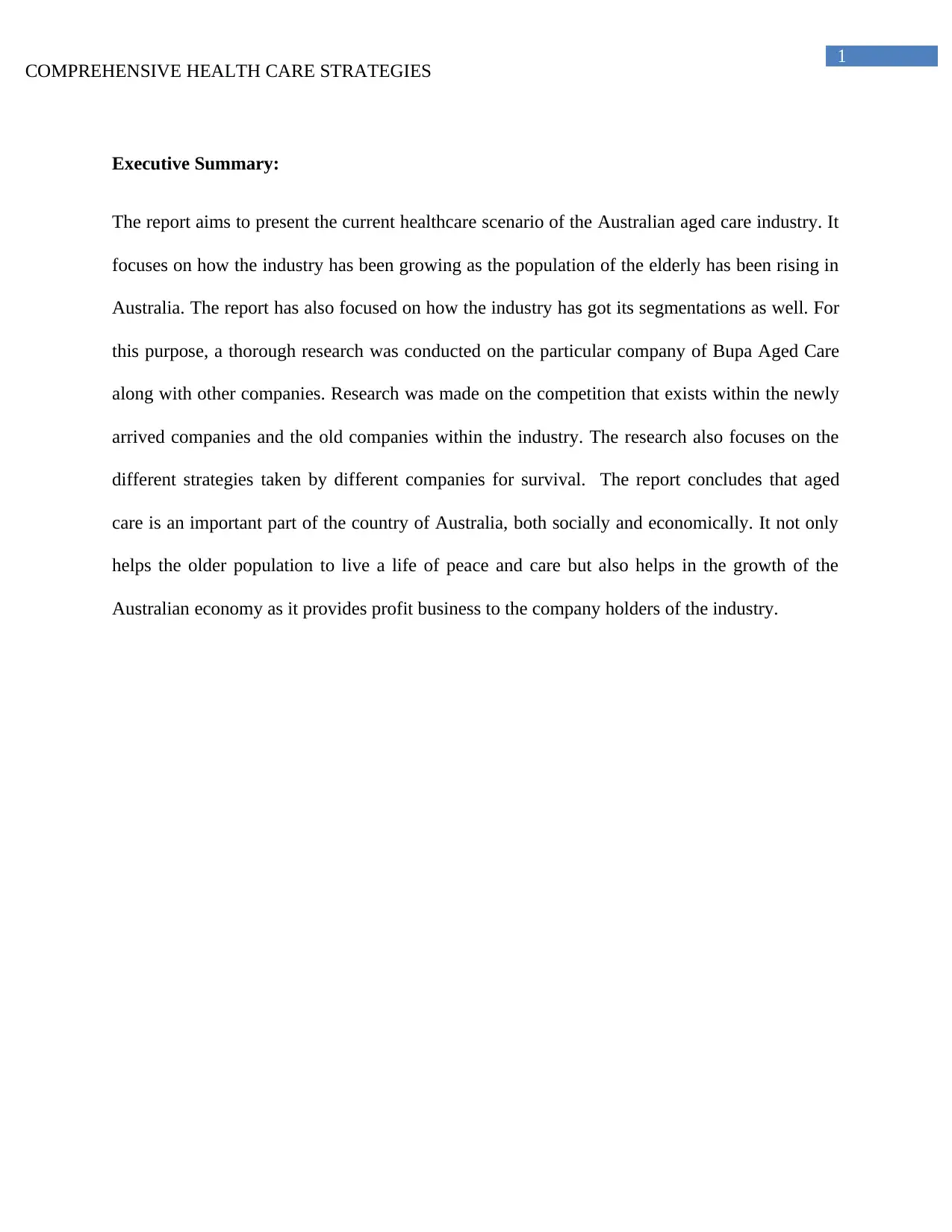
1
COMPREHENSIVE HEALTH CARE STRATEGIES
Executive Summary:
The report aims to present the current healthcare scenario of the Australian aged care industry. It
focuses on how the industry has been growing as the population of the elderly has been rising in
Australia. The report has also focused on how the industry has got its segmentations as well. For
this purpose, a thorough research was conducted on the particular company of Bupa Aged Care
along with other companies. Research was made on the competition that exists within the newly
arrived companies and the old companies within the industry. The research also focuses on the
different strategies taken by different companies for survival. The report concludes that aged
care is an important part of the country of Australia, both socially and economically. It not only
helps the older population to live a life of peace and care but also helps in the growth of the
Australian economy as it provides profit business to the company holders of the industry.
COMPREHENSIVE HEALTH CARE STRATEGIES
Executive Summary:
The report aims to present the current healthcare scenario of the Australian aged care industry. It
focuses on how the industry has been growing as the population of the elderly has been rising in
Australia. The report has also focused on how the industry has got its segmentations as well. For
this purpose, a thorough research was conducted on the particular company of Bupa Aged Care
along with other companies. Research was made on the competition that exists within the newly
arrived companies and the old companies within the industry. The research also focuses on the
different strategies taken by different companies for survival. The report concludes that aged
care is an important part of the country of Australia, both socially and economically. It not only
helps the older population to live a life of peace and care but also helps in the growth of the
Australian economy as it provides profit business to the company holders of the industry.
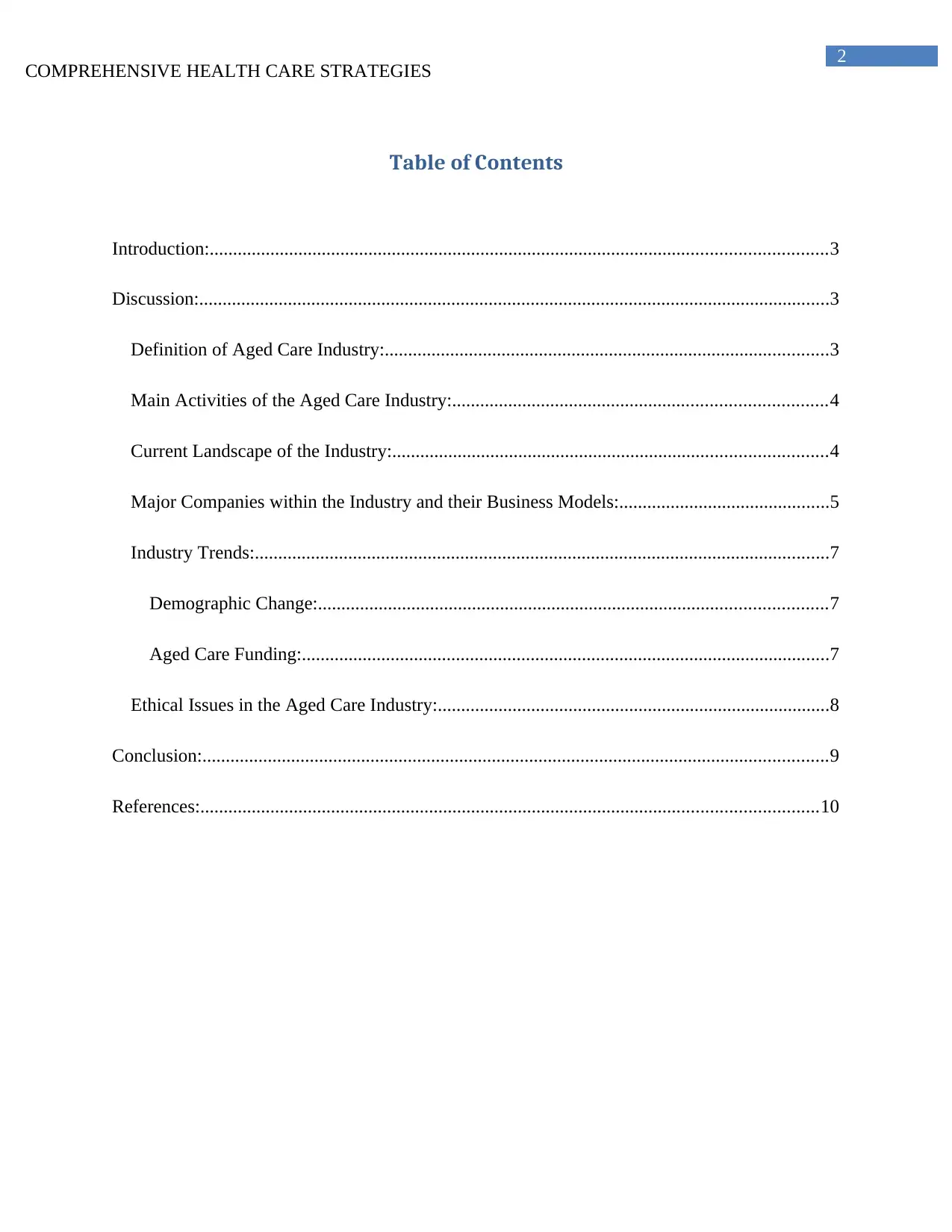
2
COMPREHENSIVE HEALTH CARE STRATEGIES
Table of Contents
Introduction:....................................................................................................................................3
Discussion:.......................................................................................................................................3
Definition of Aged Care Industry:...............................................................................................3
Main Activities of the Aged Care Industry:................................................................................4
Current Landscape of the Industry:.............................................................................................4
Major Companies within the Industry and their Business Models:.............................................5
Industry Trends:...........................................................................................................................7
Demographic Change:.............................................................................................................7
Aged Care Funding:.................................................................................................................7
Ethical Issues in the Aged Care Industry:....................................................................................8
Conclusion:......................................................................................................................................9
References:....................................................................................................................................10
COMPREHENSIVE HEALTH CARE STRATEGIES
Table of Contents
Introduction:....................................................................................................................................3
Discussion:.......................................................................................................................................3
Definition of Aged Care Industry:...............................................................................................3
Main Activities of the Aged Care Industry:................................................................................4
Current Landscape of the Industry:.............................................................................................4
Major Companies within the Industry and their Business Models:.............................................5
Industry Trends:...........................................................................................................................7
Demographic Change:.............................................................................................................7
Aged Care Funding:.................................................................................................................7
Ethical Issues in the Aged Care Industry:....................................................................................8
Conclusion:......................................................................................................................................9
References:....................................................................................................................................10
⊘ This is a preview!⊘
Do you want full access?
Subscribe today to unlock all pages.

Trusted by 1+ million students worldwide
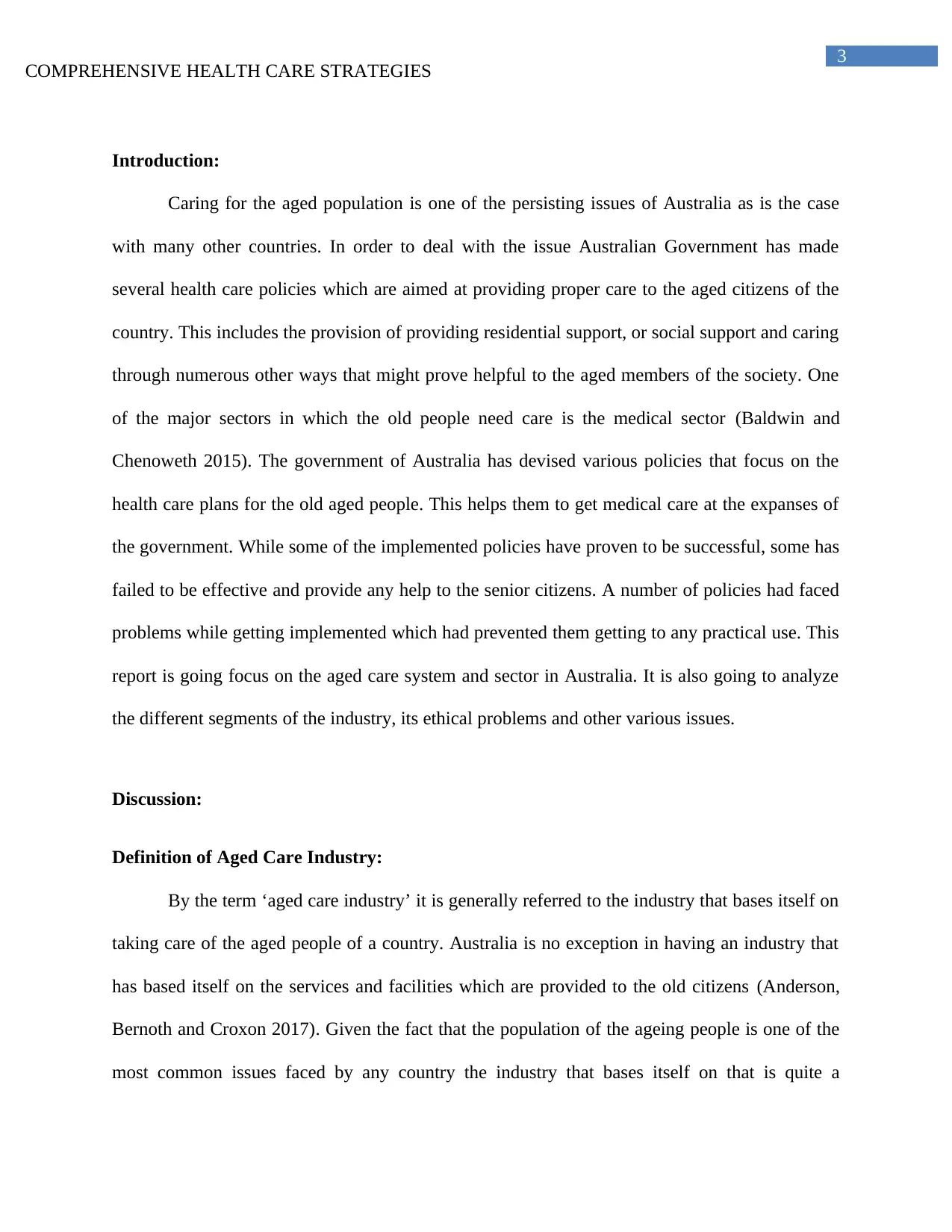
3
COMPREHENSIVE HEALTH CARE STRATEGIES
Introduction:
Caring for the aged population is one of the persisting issues of Australia as is the case
with many other countries. In order to deal with the issue Australian Government has made
several health care policies which are aimed at providing proper care to the aged citizens of the
country. This includes the provision of providing residential support, or social support and caring
through numerous other ways that might prove helpful to the aged members of the society. One
of the major sectors in which the old people need care is the medical sector (Baldwin and
Chenoweth 2015). The government of Australia has devised various policies that focus on the
health care plans for the old aged people. This helps them to get medical care at the expanses of
the government. While some of the implemented policies have proven to be successful, some has
failed to be effective and provide any help to the senior citizens. A number of policies had faced
problems while getting implemented which had prevented them getting to any practical use. This
report is going focus on the aged care system and sector in Australia. It is also going to analyze
the different segments of the industry, its ethical problems and other various issues.
Discussion:
Definition of Aged Care Industry:
By the term ‘aged care industry’ it is generally referred to the industry that bases itself on
taking care of the aged people of a country. Australia is no exception in having an industry that
has based itself on the services and facilities which are provided to the old citizens (Anderson,
Bernoth and Croxon 2017). Given the fact that the population of the ageing people is one of the
most common issues faced by any country the industry that bases itself on that is quite a
COMPREHENSIVE HEALTH CARE STRATEGIES
Introduction:
Caring for the aged population is one of the persisting issues of Australia as is the case
with many other countries. In order to deal with the issue Australian Government has made
several health care policies which are aimed at providing proper care to the aged citizens of the
country. This includes the provision of providing residential support, or social support and caring
through numerous other ways that might prove helpful to the aged members of the society. One
of the major sectors in which the old people need care is the medical sector (Baldwin and
Chenoweth 2015). The government of Australia has devised various policies that focus on the
health care plans for the old aged people. This helps them to get medical care at the expanses of
the government. While some of the implemented policies have proven to be successful, some has
failed to be effective and provide any help to the senior citizens. A number of policies had faced
problems while getting implemented which had prevented them getting to any practical use. This
report is going focus on the aged care system and sector in Australia. It is also going to analyze
the different segments of the industry, its ethical problems and other various issues.
Discussion:
Definition of Aged Care Industry:
By the term ‘aged care industry’ it is generally referred to the industry that bases itself on
taking care of the aged people of a country. Australia is no exception in having an industry that
has based itself on the services and facilities which are provided to the old citizens (Anderson,
Bernoth and Croxon 2017). Given the fact that the population of the ageing people is one of the
most common issues faced by any country the industry that bases itself on that is quite a
Paraphrase This Document
Need a fresh take? Get an instant paraphrase of this document with our AI Paraphraser
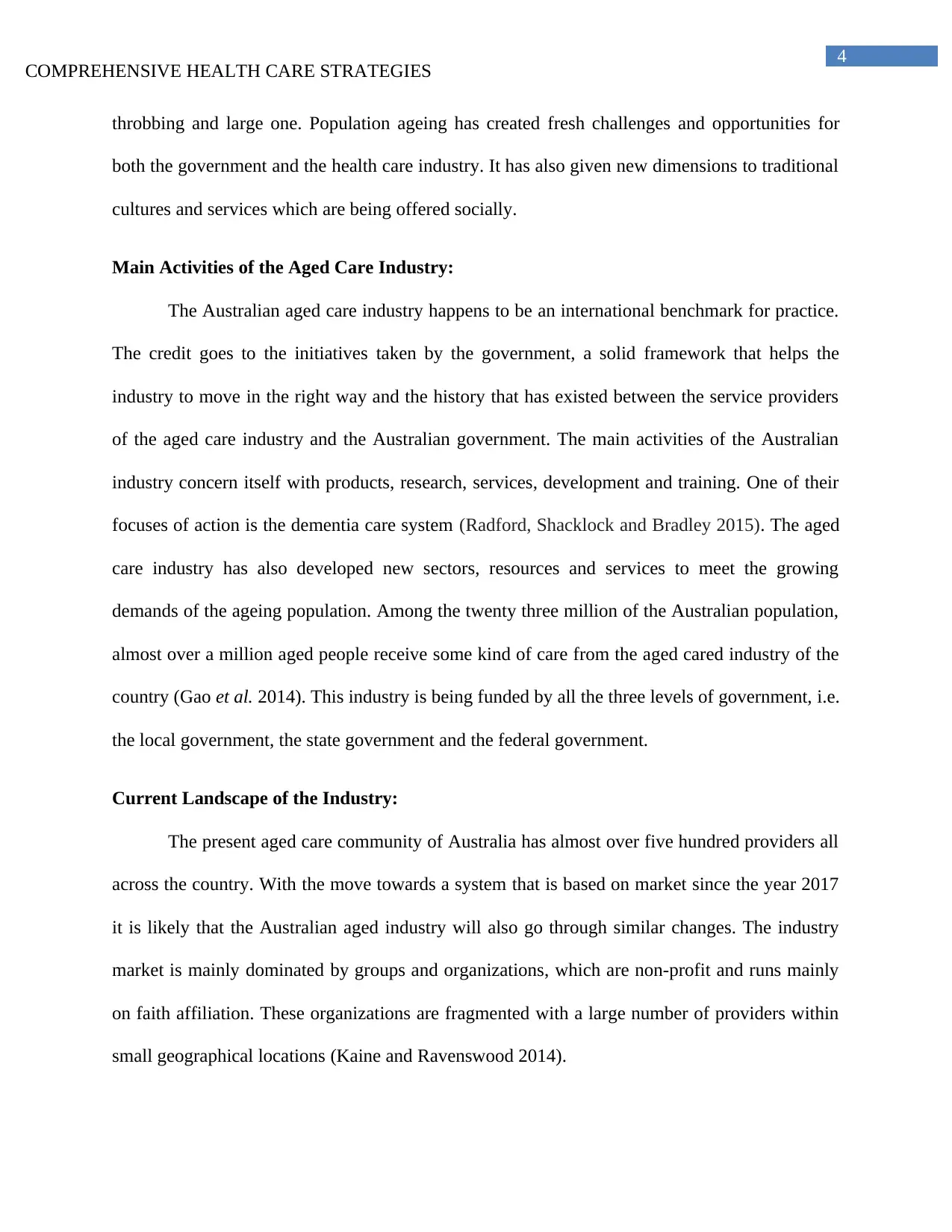
4
COMPREHENSIVE HEALTH CARE STRATEGIES
throbbing and large one. Population ageing has created fresh challenges and opportunities for
both the government and the health care industry. It has also given new dimensions to traditional
cultures and services which are being offered socially.
Main Activities of the Aged Care Industry:
The Australian aged care industry happens to be an international benchmark for practice.
The credit goes to the initiatives taken by the government, a solid framework that helps the
industry to move in the right way and the history that has existed between the service providers
of the aged care industry and the Australian government. The main activities of the Australian
industry concern itself with products, research, services, development and training. One of their
focuses of action is the dementia care system (Radford, Shacklock and Bradley 2015). The aged
care industry has also developed new sectors, resources and services to meet the growing
demands of the ageing population. Among the twenty three million of the Australian population,
almost over a million aged people receive some kind of care from the aged cared industry of the
country (Gao et al. 2014). This industry is being funded by all the three levels of government, i.e.
the local government, the state government and the federal government.
Current Landscape of the Industry:
The present aged care community of Australia has almost over five hundred providers all
across the country. With the move towards a system that is based on market since the year 2017
it is likely that the Australian aged industry will also go through similar changes. The industry
market is mainly dominated by groups and organizations, which are non-profit and runs mainly
on faith affiliation. These organizations are fragmented with a large number of providers within
small geographical locations (Kaine and Ravenswood 2014).
COMPREHENSIVE HEALTH CARE STRATEGIES
throbbing and large one. Population ageing has created fresh challenges and opportunities for
both the government and the health care industry. It has also given new dimensions to traditional
cultures and services which are being offered socially.
Main Activities of the Aged Care Industry:
The Australian aged care industry happens to be an international benchmark for practice.
The credit goes to the initiatives taken by the government, a solid framework that helps the
industry to move in the right way and the history that has existed between the service providers
of the aged care industry and the Australian government. The main activities of the Australian
industry concern itself with products, research, services, development and training. One of their
focuses of action is the dementia care system (Radford, Shacklock and Bradley 2015). The aged
care industry has also developed new sectors, resources and services to meet the growing
demands of the ageing population. Among the twenty three million of the Australian population,
almost over a million aged people receive some kind of care from the aged cared industry of the
country (Gao et al. 2014). This industry is being funded by all the three levels of government, i.e.
the local government, the state government and the federal government.
Current Landscape of the Industry:
The present aged care community of Australia has almost over five hundred providers all
across the country. With the move towards a system that is based on market since the year 2017
it is likely that the Australian aged industry will also go through similar changes. The industry
market is mainly dominated by groups and organizations, which are non-profit and runs mainly
on faith affiliation. These organizations are fragmented with a large number of providers within
small geographical locations (Kaine and Ravenswood 2014).
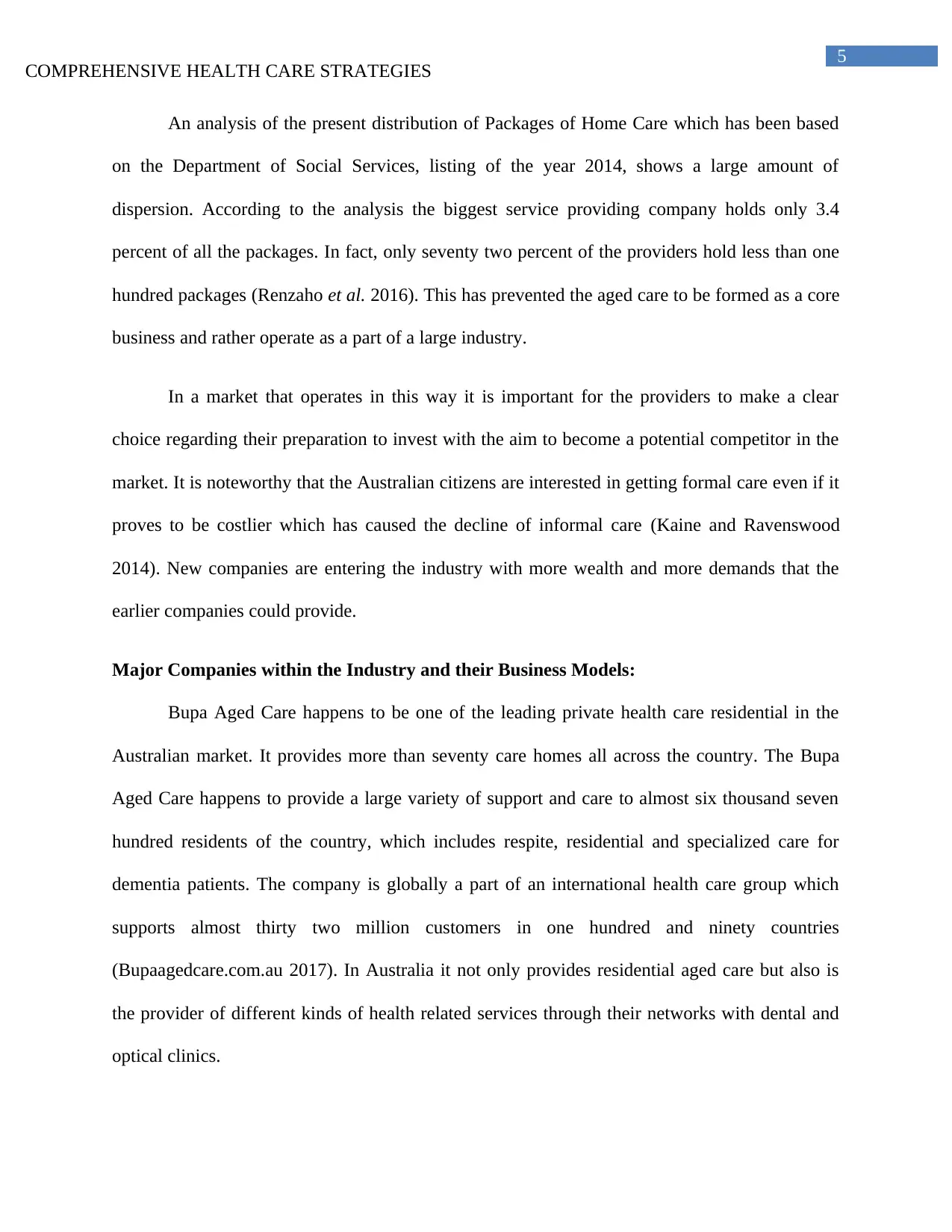
5
COMPREHENSIVE HEALTH CARE STRATEGIES
An analysis of the present distribution of Packages of Home Care which has been based
on the Department of Social Services, listing of the year 2014, shows a large amount of
dispersion. According to the analysis the biggest service providing company holds only 3.4
percent of all the packages. In fact, only seventy two percent of the providers hold less than one
hundred packages (Renzaho et al. 2016). This has prevented the aged care to be formed as a core
business and rather operate as a part of a large industry.
In a market that operates in this way it is important for the providers to make a clear
choice regarding their preparation to invest with the aim to become a potential competitor in the
market. It is noteworthy that the Australian citizens are interested in getting formal care even if it
proves to be costlier which has caused the decline of informal care (Kaine and Ravenswood
2014). New companies are entering the industry with more wealth and more demands that the
earlier companies could provide.
Major Companies within the Industry and their Business Models:
Bupa Aged Care happens to be one of the leading private health care residential in the
Australian market. It provides more than seventy care homes all across the country. The Bupa
Aged Care happens to provide a large variety of support and care to almost six thousand seven
hundred residents of the country, which includes respite, residential and specialized care for
dementia patients. The company is globally a part of an international health care group which
supports almost thirty two million customers in one hundred and ninety countries
(Bupaagedcare.com.au 2017). In Australia it not only provides residential aged care but also is
the provider of different kinds of health related services through their networks with dental and
optical clinics.
COMPREHENSIVE HEALTH CARE STRATEGIES
An analysis of the present distribution of Packages of Home Care which has been based
on the Department of Social Services, listing of the year 2014, shows a large amount of
dispersion. According to the analysis the biggest service providing company holds only 3.4
percent of all the packages. In fact, only seventy two percent of the providers hold less than one
hundred packages (Renzaho et al. 2016). This has prevented the aged care to be formed as a core
business and rather operate as a part of a large industry.
In a market that operates in this way it is important for the providers to make a clear
choice regarding their preparation to invest with the aim to become a potential competitor in the
market. It is noteworthy that the Australian citizens are interested in getting formal care even if it
proves to be costlier which has caused the decline of informal care (Kaine and Ravenswood
2014). New companies are entering the industry with more wealth and more demands that the
earlier companies could provide.
Major Companies within the Industry and their Business Models:
Bupa Aged Care happens to be one of the leading private health care residential in the
Australian market. It provides more than seventy care homes all across the country. The Bupa
Aged Care happens to provide a large variety of support and care to almost six thousand seven
hundred residents of the country, which includes respite, residential and specialized care for
dementia patients. The company is globally a part of an international health care group which
supports almost thirty two million customers in one hundred and ninety countries
(Bupaagedcare.com.au 2017). In Australia it not only provides residential aged care but also is
the provider of different kinds of health related services through their networks with dental and
optical clinics.
⊘ This is a preview!⊘
Do you want full access?
Subscribe today to unlock all pages.

Trusted by 1+ million students worldwide
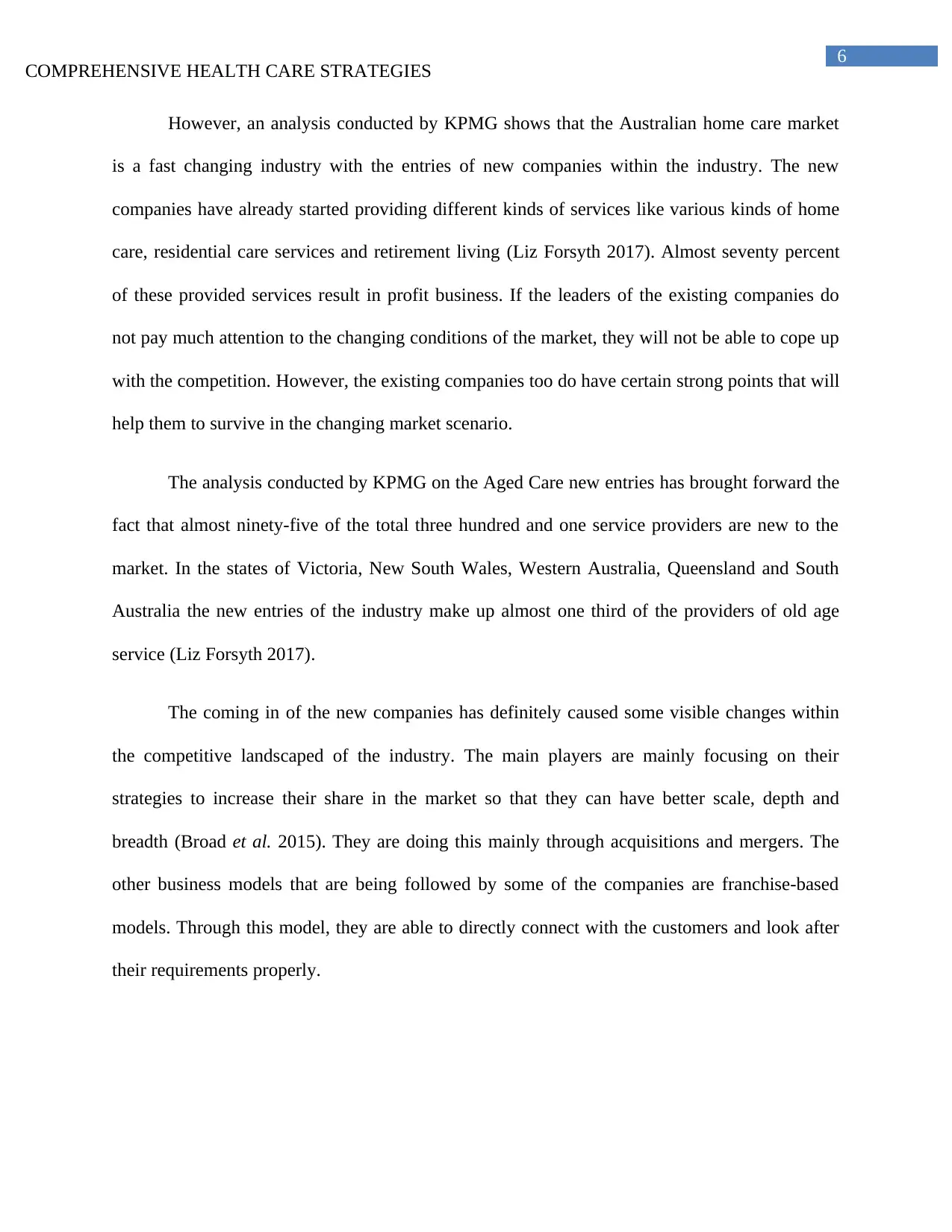
6
COMPREHENSIVE HEALTH CARE STRATEGIES
However, an analysis conducted by KPMG shows that the Australian home care market
is a fast changing industry with the entries of new companies within the industry. The new
companies have already started providing different kinds of services like various kinds of home
care, residential care services and retirement living (Liz Forsyth 2017). Almost seventy percent
of these provided services result in profit business. If the leaders of the existing companies do
not pay much attention to the changing conditions of the market, they will not be able to cope up
with the competition. However, the existing companies too do have certain strong points that will
help them to survive in the changing market scenario.
The analysis conducted by KPMG on the Aged Care new entries has brought forward the
fact that almost ninety-five of the total three hundred and one service providers are new to the
market. In the states of Victoria, New South Wales, Western Australia, Queensland and South
Australia the new entries of the industry make up almost one third of the providers of old age
service (Liz Forsyth 2017).
The coming in of the new companies has definitely caused some visible changes within
the competitive landscaped of the industry. The main players are mainly focusing on their
strategies to increase their share in the market so that they can have better scale, depth and
breadth (Broad et al. 2015). They are doing this mainly through acquisitions and mergers. The
other business models that are being followed by some of the companies are franchise-based
models. Through this model, they are able to directly connect with the customers and look after
their requirements properly.
COMPREHENSIVE HEALTH CARE STRATEGIES
However, an analysis conducted by KPMG shows that the Australian home care market
is a fast changing industry with the entries of new companies within the industry. The new
companies have already started providing different kinds of services like various kinds of home
care, residential care services and retirement living (Liz Forsyth 2017). Almost seventy percent
of these provided services result in profit business. If the leaders of the existing companies do
not pay much attention to the changing conditions of the market, they will not be able to cope up
with the competition. However, the existing companies too do have certain strong points that will
help them to survive in the changing market scenario.
The analysis conducted by KPMG on the Aged Care new entries has brought forward the
fact that almost ninety-five of the total three hundred and one service providers are new to the
market. In the states of Victoria, New South Wales, Western Australia, Queensland and South
Australia the new entries of the industry make up almost one third of the providers of old age
service (Liz Forsyth 2017).
The coming in of the new companies has definitely caused some visible changes within
the competitive landscaped of the industry. The main players are mainly focusing on their
strategies to increase their share in the market so that they can have better scale, depth and
breadth (Broad et al. 2015). They are doing this mainly through acquisitions and mergers. The
other business models that are being followed by some of the companies are franchise-based
models. Through this model, they are able to directly connect with the customers and look after
their requirements properly.
Paraphrase This Document
Need a fresh take? Get an instant paraphrase of this document with our AI Paraphraser
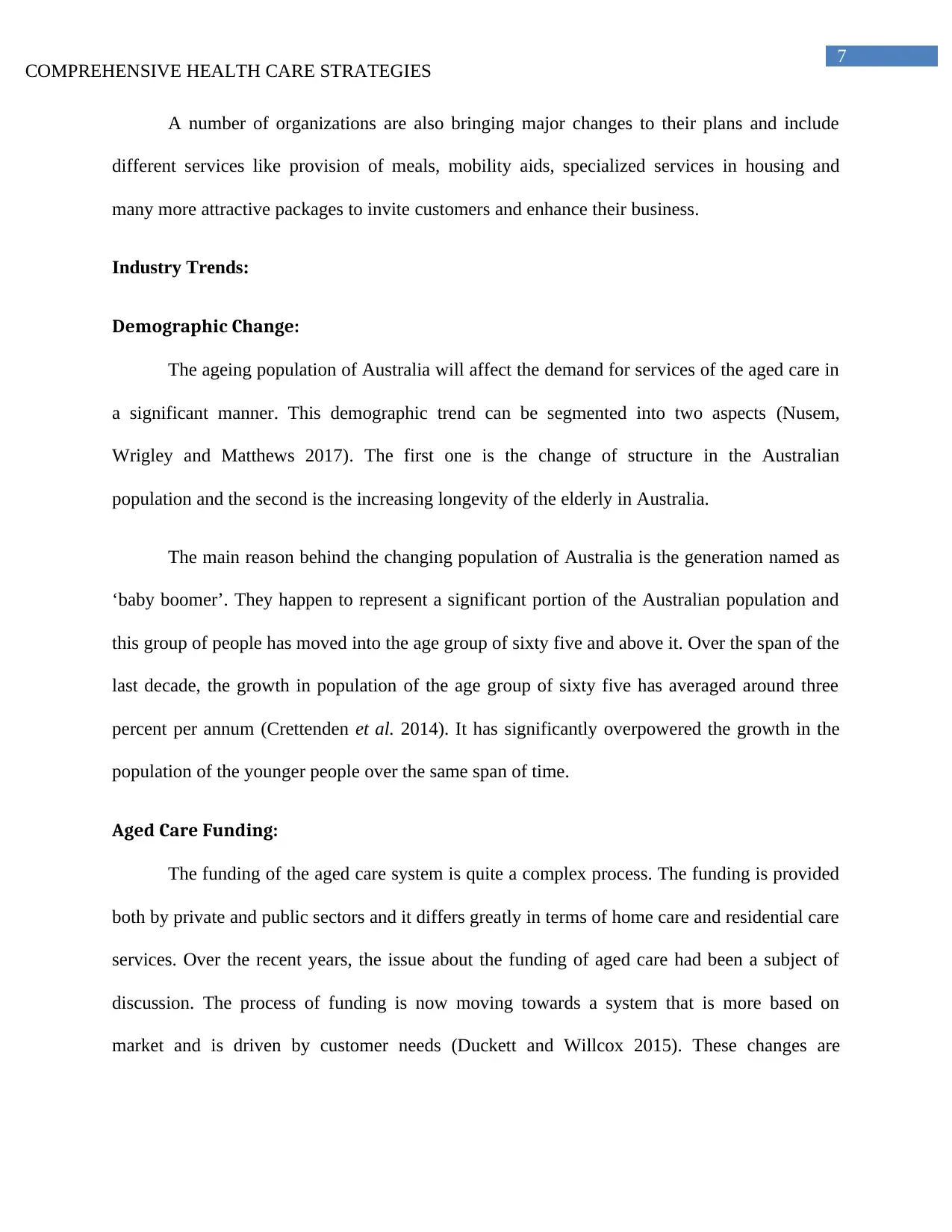
7
COMPREHENSIVE HEALTH CARE STRATEGIES
A number of organizations are also bringing major changes to their plans and include
different services like provision of meals, mobility aids, specialized services in housing and
many more attractive packages to invite customers and enhance their business.
Industry Trends:
Demographic Change:
The ageing population of Australia will affect the demand for services of the aged care in
a significant manner. This demographic trend can be segmented into two aspects (Nusem,
Wrigley and Matthews 2017). The first one is the change of structure in the Australian
population and the second is the increasing longevity of the elderly in Australia.
The main reason behind the changing population of Australia is the generation named as
‘baby boomer’. They happen to represent a significant portion of the Australian population and
this group of people has moved into the age group of sixty five and above it. Over the span of the
last decade, the growth in population of the age group of sixty five has averaged around three
percent per annum (Crettenden et al. 2014). It has significantly overpowered the growth in the
population of the younger people over the same span of time.
Aged Care Funding:
The funding of the aged care system is quite a complex process. The funding is provided
both by private and public sectors and it differs greatly in terms of home care and residential care
services. Over the recent years, the issue about the funding of aged care had been a subject of
discussion. The process of funding is now moving towards a system that is more based on
market and is driven by customer needs (Duckett and Willcox 2015). These changes are
COMPREHENSIVE HEALTH CARE STRATEGIES
A number of organizations are also bringing major changes to their plans and include
different services like provision of meals, mobility aids, specialized services in housing and
many more attractive packages to invite customers and enhance their business.
Industry Trends:
Demographic Change:
The ageing population of Australia will affect the demand for services of the aged care in
a significant manner. This demographic trend can be segmented into two aspects (Nusem,
Wrigley and Matthews 2017). The first one is the change of structure in the Australian
population and the second is the increasing longevity of the elderly in Australia.
The main reason behind the changing population of Australia is the generation named as
‘baby boomer’. They happen to represent a significant portion of the Australian population and
this group of people has moved into the age group of sixty five and above it. Over the span of the
last decade, the growth in population of the age group of sixty five has averaged around three
percent per annum (Crettenden et al. 2014). It has significantly overpowered the growth in the
population of the younger people over the same span of time.
Aged Care Funding:
The funding of the aged care system is quite a complex process. The funding is provided
both by private and public sectors and it differs greatly in terms of home care and residential care
services. Over the recent years, the issue about the funding of aged care had been a subject of
discussion. The process of funding is now moving towards a system that is more based on
market and is driven by customer needs (Duckett and Willcox 2015). These changes are
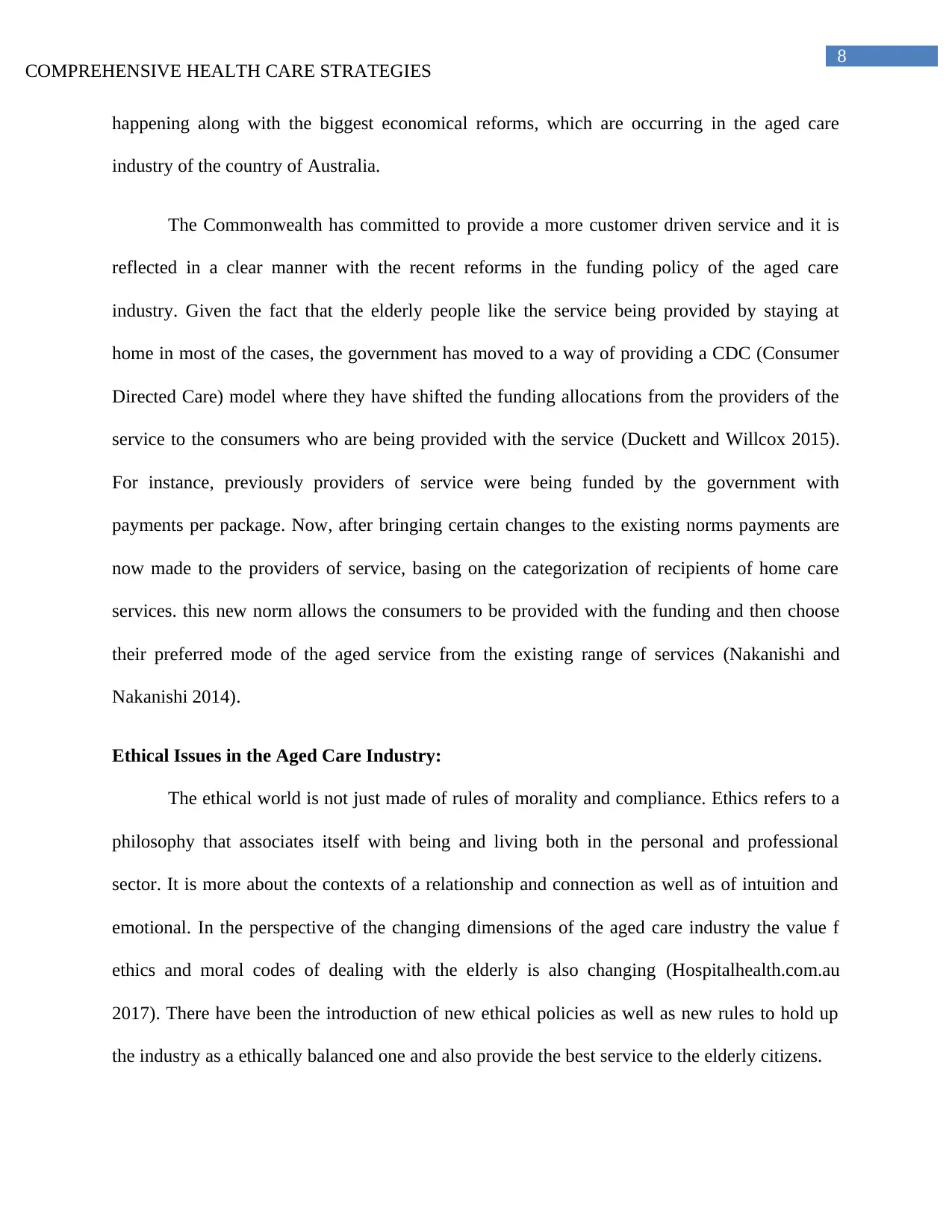
8
COMPREHENSIVE HEALTH CARE STRATEGIES
happening along with the biggest economical reforms, which are occurring in the aged care
industry of the country of Australia.
The Commonwealth has committed to provide a more customer driven service and it is
reflected in a clear manner with the recent reforms in the funding policy of the aged care
industry. Given the fact that the elderly people like the service being provided by staying at
home in most of the cases, the government has moved to a way of providing a CDC (Consumer
Directed Care) model where they have shifted the funding allocations from the providers of the
service to the consumers who are being provided with the service (Duckett and Willcox 2015).
For instance, previously providers of service were being funded by the government with
payments per package. Now, after bringing certain changes to the existing norms payments are
now made to the providers of service, basing on the categorization of recipients of home care
services. this new norm allows the consumers to be provided with the funding and then choose
their preferred mode of the aged service from the existing range of services (Nakanishi and
Nakanishi 2014).
Ethical Issues in the Aged Care Industry:
The ethical world is not just made of rules of morality and compliance. Ethics refers to a
philosophy that associates itself with being and living both in the personal and professional
sector. It is more about the contexts of a relationship and connection as well as of intuition and
emotional. In the perspective of the changing dimensions of the aged care industry the value f
ethics and moral codes of dealing with the elderly is also changing (Hospitalhealth.com.au
2017). There have been the introduction of new ethical policies as well as new rules to hold up
the industry as a ethically balanced one and also provide the best service to the elderly citizens.
COMPREHENSIVE HEALTH CARE STRATEGIES
happening along with the biggest economical reforms, which are occurring in the aged care
industry of the country of Australia.
The Commonwealth has committed to provide a more customer driven service and it is
reflected in a clear manner with the recent reforms in the funding policy of the aged care
industry. Given the fact that the elderly people like the service being provided by staying at
home in most of the cases, the government has moved to a way of providing a CDC (Consumer
Directed Care) model where they have shifted the funding allocations from the providers of the
service to the consumers who are being provided with the service (Duckett and Willcox 2015).
For instance, previously providers of service were being funded by the government with
payments per package. Now, after bringing certain changes to the existing norms payments are
now made to the providers of service, basing on the categorization of recipients of home care
services. this new norm allows the consumers to be provided with the funding and then choose
their preferred mode of the aged service from the existing range of services (Nakanishi and
Nakanishi 2014).
Ethical Issues in the Aged Care Industry:
The ethical world is not just made of rules of morality and compliance. Ethics refers to a
philosophy that associates itself with being and living both in the personal and professional
sector. It is more about the contexts of a relationship and connection as well as of intuition and
emotional. In the perspective of the changing dimensions of the aged care industry the value f
ethics and moral codes of dealing with the elderly is also changing (Hospitalhealth.com.au
2017). There have been the introduction of new ethical policies as well as new rules to hold up
the industry as a ethically balanced one and also provide the best service to the elderly citizens.
⊘ This is a preview!⊘
Do you want full access?
Subscribe today to unlock all pages.

Trusted by 1+ million students worldwide
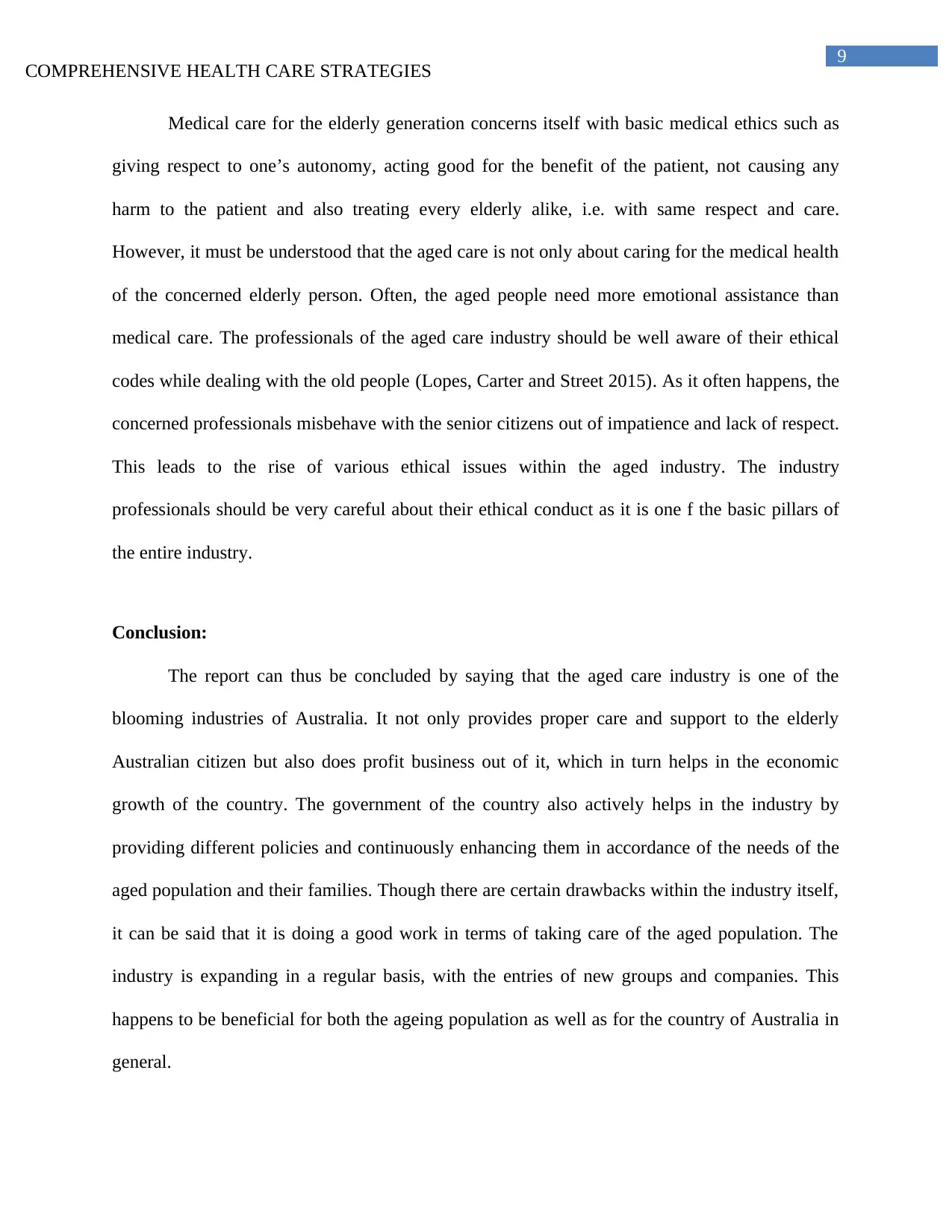
9
COMPREHENSIVE HEALTH CARE STRATEGIES
Medical care for the elderly generation concerns itself with basic medical ethics such as
giving respect to one’s autonomy, acting good for the benefit of the patient, not causing any
harm to the patient and also treating every elderly alike, i.e. with same respect and care.
However, it must be understood that the aged care is not only about caring for the medical health
of the concerned elderly person. Often, the aged people need more emotional assistance than
medical care. The professionals of the aged care industry should be well aware of their ethical
codes while dealing with the old people (Lopes, Carter and Street 2015). As it often happens, the
concerned professionals misbehave with the senior citizens out of impatience and lack of respect.
This leads to the rise of various ethical issues within the aged industry. The industry
professionals should be very careful about their ethical conduct as it is one f the basic pillars of
the entire industry.
Conclusion:
The report can thus be concluded by saying that the aged care industry is one of the
blooming industries of Australia. It not only provides proper care and support to the elderly
Australian citizen but also does profit business out of it, which in turn helps in the economic
growth of the country. The government of the country also actively helps in the industry by
providing different policies and continuously enhancing them in accordance of the needs of the
aged population and their families. Though there are certain drawbacks within the industry itself,
it can be said that it is doing a good work in terms of taking care of the aged population. The
industry is expanding in a regular basis, with the entries of new groups and companies. This
happens to be beneficial for both the ageing population as well as for the country of Australia in
general.
COMPREHENSIVE HEALTH CARE STRATEGIES
Medical care for the elderly generation concerns itself with basic medical ethics such as
giving respect to one’s autonomy, acting good for the benefit of the patient, not causing any
harm to the patient and also treating every elderly alike, i.e. with same respect and care.
However, it must be understood that the aged care is not only about caring for the medical health
of the concerned elderly person. Often, the aged people need more emotional assistance than
medical care. The professionals of the aged care industry should be well aware of their ethical
codes while dealing with the old people (Lopes, Carter and Street 2015). As it often happens, the
concerned professionals misbehave with the senior citizens out of impatience and lack of respect.
This leads to the rise of various ethical issues within the aged industry. The industry
professionals should be very careful about their ethical conduct as it is one f the basic pillars of
the entire industry.
Conclusion:
The report can thus be concluded by saying that the aged care industry is one of the
blooming industries of Australia. It not only provides proper care and support to the elderly
Australian citizen but also does profit business out of it, which in turn helps in the economic
growth of the country. The government of the country also actively helps in the industry by
providing different policies and continuously enhancing them in accordance of the needs of the
aged population and their families. Though there are certain drawbacks within the industry itself,
it can be said that it is doing a good work in terms of taking care of the aged population. The
industry is expanding in a regular basis, with the entries of new groups and companies. This
happens to be beneficial for both the ageing population as well as for the country of Australia in
general.
Paraphrase This Document
Need a fresh take? Get an instant paraphrase of this document with our AI Paraphraser

10
COMPREHENSIVE HEALTH CARE STRATEGIES
References:
Anderson, J., Bernoth, M. and Croxon, L., 2017. Partnerships for learning and mentoring in aged
care. Australian Nursing and Midwifery Journal, 24(7), p.36.
Baldwin, R. and Chenoweth, L., 2015. Residential Aged Care Policy in Australia–Are We
Learning from Evidence?. Australian Journal of Public Administration, 74(2), pp.128-141.
Broad, J.B., Ashton, T., Gott, M., McLeod, H., Davis, P.B. and Connolly, M.J., 2015. Likelihood
of residential aged care use in later life: A simple approach to estimation with international
comparison. Australian and New Zealand journal of public health, 39(4), pp.374-379.
Bupaagedcare.com.au. (2017). Cite a Website - Cite This For Me. [online] Available at:
https://www.bupaagedcare.com.au/ [Accessed 8 Dec. 2017].
Chenoweth, L., Merlyn, T., Jeon, Y.H., Tait, F. and Duffield, C., 2014. Attracting and retaining
qualified nurses in aged and dementia care: Outcomes from an Australian study. Journal of
Nursing Management, 22(2), pp.234-247.
Crettenden, I.F., McCarty, M.V., Fenech, B.J., Heywood, T., Taitz, M.C. and Tudman, S., 2014.
How evidence-based workforce planning in Australia is informing policy development in the
retention and distribution of the health workforce. Human Resources for Health, 12, p.7.
Duckett, S. and Willcox, S., 2015. The Australian health care system (No. Ed. 5). Oxford
University Press.
Gao, F., Newcombe, P., Tilse, C., Wilson, J. and Tuckett, A., 2014. Models for predicting
turnover of residential aged care nurses: A structural equation modelling analysis of secondary
data. International Journal of Nursing Studies, 51(9), pp.1258-1270.
COMPREHENSIVE HEALTH CARE STRATEGIES
References:
Anderson, J., Bernoth, M. and Croxon, L., 2017. Partnerships for learning and mentoring in aged
care. Australian Nursing and Midwifery Journal, 24(7), p.36.
Baldwin, R. and Chenoweth, L., 2015. Residential Aged Care Policy in Australia–Are We
Learning from Evidence?. Australian Journal of Public Administration, 74(2), pp.128-141.
Broad, J.B., Ashton, T., Gott, M., McLeod, H., Davis, P.B. and Connolly, M.J., 2015. Likelihood
of residential aged care use in later life: A simple approach to estimation with international
comparison. Australian and New Zealand journal of public health, 39(4), pp.374-379.
Bupaagedcare.com.au. (2017). Cite a Website - Cite This For Me. [online] Available at:
https://www.bupaagedcare.com.au/ [Accessed 8 Dec. 2017].
Chenoweth, L., Merlyn, T., Jeon, Y.H., Tait, F. and Duffield, C., 2014. Attracting and retaining
qualified nurses in aged and dementia care: Outcomes from an Australian study. Journal of
Nursing Management, 22(2), pp.234-247.
Crettenden, I.F., McCarty, M.V., Fenech, B.J., Heywood, T., Taitz, M.C. and Tudman, S., 2014.
How evidence-based workforce planning in Australia is informing policy development in the
retention and distribution of the health workforce. Human Resources for Health, 12, p.7.
Duckett, S. and Willcox, S., 2015. The Australian health care system (No. Ed. 5). Oxford
University Press.
Gao, F., Newcombe, P., Tilse, C., Wilson, J. and Tuckett, A., 2014. Models for predicting
turnover of residential aged care nurses: A structural equation modelling analysis of secondary
data. International Journal of Nursing Studies, 51(9), pp.1258-1270.
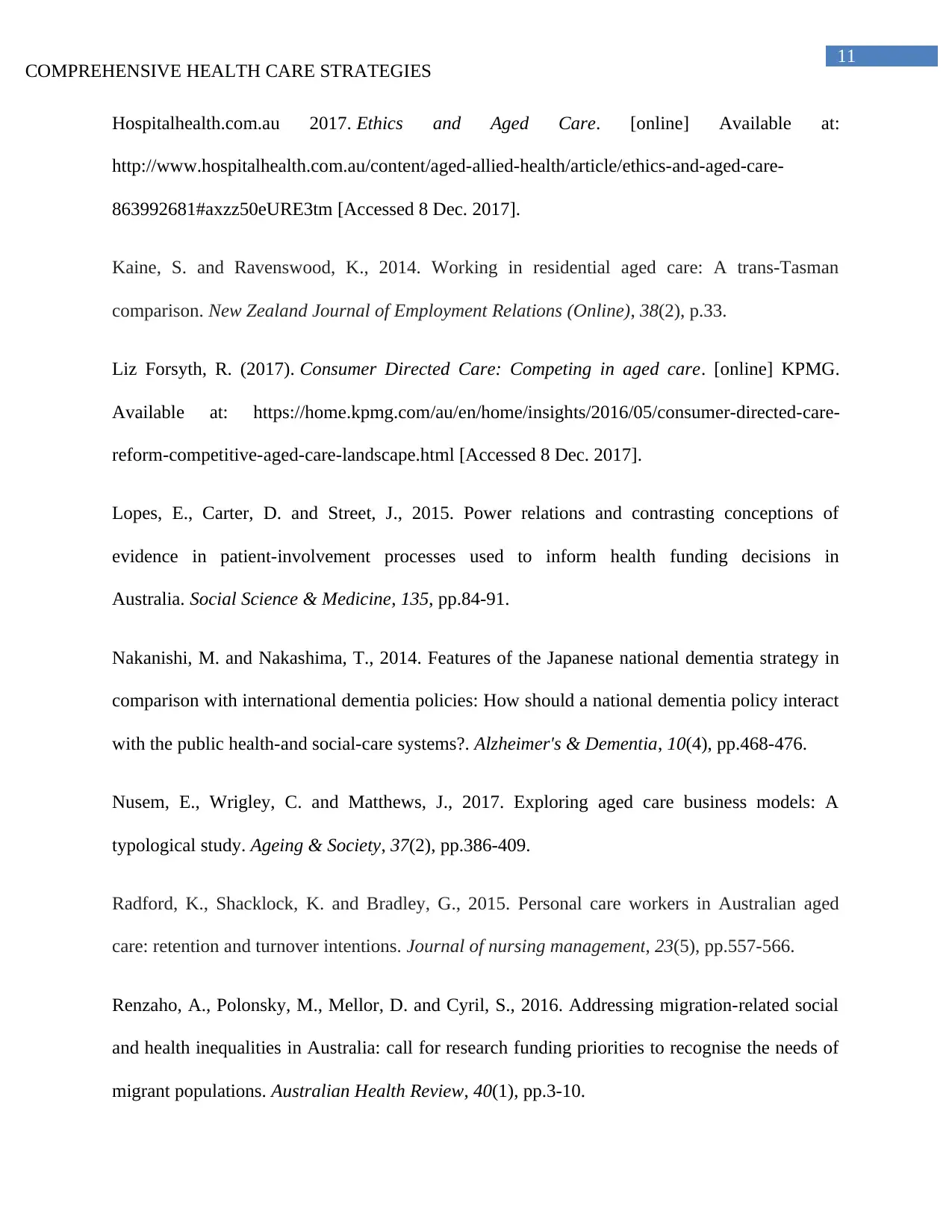
11
COMPREHENSIVE HEALTH CARE STRATEGIES
Hospitalhealth.com.au 2017. Ethics and Aged Care. [online] Available at:
http://www.hospitalhealth.com.au/content/aged-allied-health/article/ethics-and-aged-care-
863992681#axzz50eURE3tm [Accessed 8 Dec. 2017].
Kaine, S. and Ravenswood, K., 2014. Working in residential aged care: A trans-Tasman
comparison. New Zealand Journal of Employment Relations (Online), 38(2), p.33.
Liz Forsyth, R. (2017). Consumer Directed Care: Competing in aged care. [online] KPMG.
Available at: https://home.kpmg.com/au/en/home/insights/2016/05/consumer-directed-care-
reform-competitive-aged-care-landscape.html [Accessed 8 Dec. 2017].
Lopes, E., Carter, D. and Street, J., 2015. Power relations and contrasting conceptions of
evidence in patient-involvement processes used to inform health funding decisions in
Australia. Social Science & Medicine, 135, pp.84-91.
Nakanishi, M. and Nakashima, T., 2014. Features of the Japanese national dementia strategy in
comparison with international dementia policies: How should a national dementia policy interact
with the public health-and social-care systems?. Alzheimer's & Dementia, 10(4), pp.468-476.
Nusem, E., Wrigley, C. and Matthews, J., 2017. Exploring aged care business models: A
typological study. Ageing & Society, 37(2), pp.386-409.
Radford, K., Shacklock, K. and Bradley, G., 2015. Personal care workers in Australian aged
care: retention and turnover intentions. Journal of nursing management, 23(5), pp.557-566.
Renzaho, A., Polonsky, M., Mellor, D. and Cyril, S., 2016. Addressing migration-related social
and health inequalities in Australia: call for research funding priorities to recognise the needs of
migrant populations. Australian Health Review, 40(1), pp.3-10.
COMPREHENSIVE HEALTH CARE STRATEGIES
Hospitalhealth.com.au 2017. Ethics and Aged Care. [online] Available at:
http://www.hospitalhealth.com.au/content/aged-allied-health/article/ethics-and-aged-care-
863992681#axzz50eURE3tm [Accessed 8 Dec. 2017].
Kaine, S. and Ravenswood, K., 2014. Working in residential aged care: A trans-Tasman
comparison. New Zealand Journal of Employment Relations (Online), 38(2), p.33.
Liz Forsyth, R. (2017). Consumer Directed Care: Competing in aged care. [online] KPMG.
Available at: https://home.kpmg.com/au/en/home/insights/2016/05/consumer-directed-care-
reform-competitive-aged-care-landscape.html [Accessed 8 Dec. 2017].
Lopes, E., Carter, D. and Street, J., 2015. Power relations and contrasting conceptions of
evidence in patient-involvement processes used to inform health funding decisions in
Australia. Social Science & Medicine, 135, pp.84-91.
Nakanishi, M. and Nakashima, T., 2014. Features of the Japanese national dementia strategy in
comparison with international dementia policies: How should a national dementia policy interact
with the public health-and social-care systems?. Alzheimer's & Dementia, 10(4), pp.468-476.
Nusem, E., Wrigley, C. and Matthews, J., 2017. Exploring aged care business models: A
typological study. Ageing & Society, 37(2), pp.386-409.
Radford, K., Shacklock, K. and Bradley, G., 2015. Personal care workers in Australian aged
care: retention and turnover intentions. Journal of nursing management, 23(5), pp.557-566.
Renzaho, A., Polonsky, M., Mellor, D. and Cyril, S., 2016. Addressing migration-related social
and health inequalities in Australia: call for research funding priorities to recognise the needs of
migrant populations. Australian Health Review, 40(1), pp.3-10.
⊘ This is a preview!⊘
Do you want full access?
Subscribe today to unlock all pages.

Trusted by 1+ million students worldwide
1 out of 12
Related Documents
Your All-in-One AI-Powered Toolkit for Academic Success.
+13062052269
info@desklib.com
Available 24*7 on WhatsApp / Email
![[object Object]](/_next/static/media/star-bottom.7253800d.svg)
Unlock your academic potential
Copyright © 2020–2025 A2Z Services. All Rights Reserved. Developed and managed by ZUCOL.




